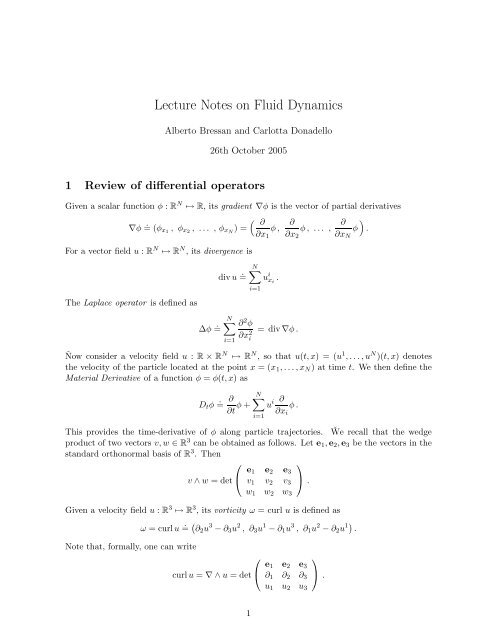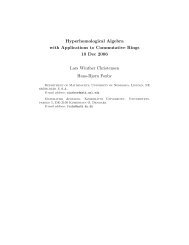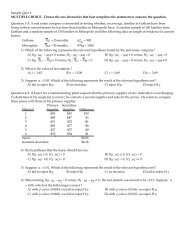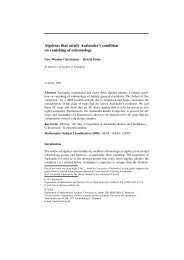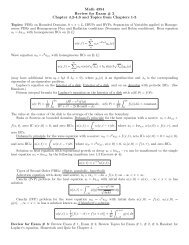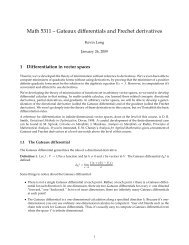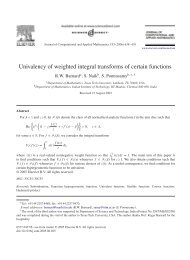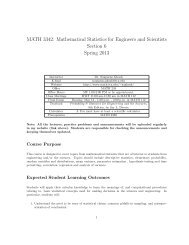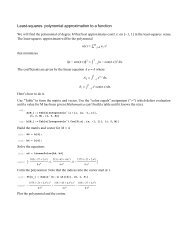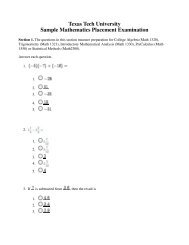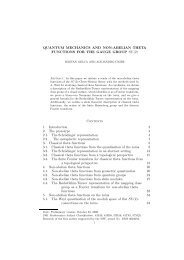You also want an ePaper? Increase the reach of your titles
YUMPU automatically turns print PDFs into web optimized ePapers that Google loves.
<str<strong>on</strong>g>Lecture</str<strong>on</strong>g> <str<strong>on</strong>g>Notes</str<strong>on</strong>g> <strong>on</strong> <strong>Fluid</strong> <strong>Dynamics</strong>Alberto Bressan and Carlotta D<strong>on</strong>adello26th October 20051 Review of differential operatorsGiven a scalar functi<strong>on</strong> φ : R N ↦→ R, its gradient ∇φ is the vector of partial derivatives∇φ = . ( ∂ ∂∂)(φ x1 , φ x2 , . . . , φ xN ) = φ , φ , . . . , φ .∂x 1 ∂x 2 ∂x NFor a vector field u : R N ↦→ R N , its divergence isThe Laplace operator is defined asdiv u . =N∑u i x i.i=1∆φ . =N∑i=1∂ 2 φ∂x 2 i= div ∇φ .Ňow c<strong>on</strong>sider a velocity field u : R × R N ↦→ R N , so that u(t, x) = (u 1 , . . . , u N )(t, x) denotesthe velocity of the particle located at the point x = (x 1 , . . . , x N ) at time t. We then define theMaterial Derivative of a functi<strong>on</strong> φ = φ(t, x) asD t φ . = ∂ ∂t φ + N ∑i=1u i∂φ .∂x iThis provides the time-derivative of φ al<strong>on</strong>g particle trajectories. ˇWe recall that the wedgeproduct of two vectors v, w ∈ R 3 can be obtained as follows. Let e 1 , e 2 , e 3 be the vectors in thestandard orth<strong>on</strong>ormal basis of R 3 . Then⎛⎞e 1 e 2 e 3v ∧ w = det ⎝ v 1 v 2 v 3⎠ .w 1 w 2 w 3Given a velocity field u : R 3 ↦→ R 3 , its vorticity ω = curl u is defined asNote that, formally, <strong>on</strong>e can writeω = curl u . = ( ∂ 2 u 3 − ∂ 3 u 2 , ∂ 3 u 1 − ∂ 1 u 3 , ∂ 1 u 2 − ∂ 2 u 1) .⎛curl u = ∇ ∧ u = det ⎝⎞e 1 e 2 e 3∂ 1 ∂ 2 ∂ 3⎠ .u 1 u 2 u 31
2 Euler and Navier-Stokes equati<strong>on</strong>sfor a homogeneous incompressible fluidThe flow of a homogeneous incompressible, n<strong>on</strong>-viscous fluid in R N is modelled by the systemof Euler equati<strong>on</strong>s⎧⎨ D t u(t, x) = −∇p(t, x), balance of momentumdiv u(t, x) ≡ 0,incompressibility c<strong>on</strong>diti<strong>on</strong>(1)⎩u(0, x) = u 0 (x),initial dataWherelatex fluid.text is time,x ∈ R N is the Eulerian space variable,u = (u 1 , . . . , u N ) is the fluid velocity,p is the scalar pressure,D t = ∂ t + u · ∇ x is the material derivative.When viscosity is present, an additi<strong>on</strong>al diffusi<strong>on</strong> term is present in the momentum equati<strong>on</strong>.This leads to the Navier-Stokes equati<strong>on</strong>s:⎧⎨ D t u(t, x) = −∇p(t, x) + ν∆u, balance of momentumdiv u(t, x) ≡ 0,incompressibility c<strong>on</strong>diti<strong>on</strong>(2)⎩u(0, x) = u 0 (x),initial dataThe positive c<strong>on</strong>stant ν is the coefficient of kinematic viscosity. Its reciprocal is called theReynolds number: Re = 1/ν.Ǐf the fluid moti<strong>on</strong> takes place in a bounded set Ω ⊂ R N , <strong>on</strong>e must add suitable boundaryc<strong>on</strong>diti<strong>on</strong>s. In the case of the inviscid Euler equati<strong>on</strong>s, <strong>on</strong>e requires that the velocity u of thefluid is tangential to the boundary ∂Ω. Calling n the unit outer normal, we thus haven · u = 0 x ∈ ∂Ω . (3)In the presence of viscosity, instead of (3), the Navier-Stokes equati<strong>on</strong>s are supplemented bythe n<strong>on</strong>-slip boundary c<strong>on</strong>diti<strong>on</strong>su = 0 x ∈ ∂Ω . (4)2.1 Derivati<strong>on</strong> of Euler equati<strong>on</strong> from the balance law of momentumC<strong>on</strong>sider any regi<strong>on</strong> W 0 ⊂ R n . Denote by W t the regi<strong>on</strong> occupied at time t > 0 by those fluidparticles which are initially in W 0 . Assume that the <strong>on</strong>ly force acting <strong>on</strong> the fluid through theboundary ∂W t is the pressure. Then the balance law of momentum takes the formddt∫W tu dV = [total forces across the boundary]∫= − p n dA.∂W tIf e is any fixed vector in R N by the divergence theorem we get∫∫p e · n dA = div(p e) dV∂W t W∫ t= ∇p · e dV.W t2(5)(6)
Then:∫ ∫∫du dV = D t u dV = − ∇p dV, (7)dt W t W t W tfor any regi<strong>on</strong> W t in the fluid at time t. Hence the equality holds also in the differential form:D t u = −∇pEuler equati<strong>on</strong>.2.2 Symmetry groups for the Euler and Navier-Stokes equati<strong>on</strong>sAssume that u = u(t, x) and p = p(t, x) provide a soluti<strong>on</strong> to Euler or Navier-Stokes equati<strong>on</strong>.Further soluti<strong>on</strong>s can then be obtained by various variable transformati<strong>on</strong>s.• Translati<strong>on</strong> Invariance: For any c<strong>on</strong>stant vector c in R N{ u c (t, x) := u(t, x − ct) + c,p c (t, x) := p(t, x − ct),is another soluti<strong>on</strong>.• Rotati<strong>on</strong> Invariance: For any orthog<strong>on</strong>al matrix Q{ u Q (t, x) := Q T u(t, Qx),p Q (t, x) := p(t, Qx),is another soluti<strong>on</strong>.• Scale Invariance: If u, p provide a soluti<strong>on</strong> to the Euler equati<strong>on</strong>s, then for any λ, τ > 0the functi<strong>on</strong>s⎧⎨ u λ, τ (t, x) := λ τ u( t τ , x λ ),(A)⎩p λ, τ (t, x) := λ2τp( t 2 τ , x λ ),provide a 2-parameters family of soluti<strong>on</strong>s to the Euler equati<strong>on</strong>.If u, p are a soluti<strong>on</strong> to the Navier-Stokes equati<strong>on</strong>s, then for all τ > 0 the functi<strong>on</strong>s⎧⎨ u τ (t, x) := τ −1/2 u( t τ , x),τ 1/2(B)⎩p τ (t, x) := τ −1 p( t τ ,xτ 1/2 ).provide a 1-parameter family of soluti<strong>on</strong>s to the Navier-Stokes equati<strong>on</strong> for τ ∈ R. Observethat (A) coincides with (B) when λ = τ 1/23 Particle trajectoriesGiven a fluid flow with velocity field u (not necessarily incompressible), the particle trajectorymappingX : [0, ∞) × R N −→ R N(8)t , α ↦→ X(t, α)describes the trajectory of the particle which is initially located at point α = (α 1 , . . . , α N ) attime t = 0. The Lagrangian variable α, can be regarded as a particle marker. The functi<strong>on</strong>X(t, α) is determined by solving the Cauchy problem⎧⎨⎩∂∂tX(t, α) = u(t, X(t, α)),X(0, α) = α.3
An initial domain W 0 ⊂ R N in the fluid evolves in time toX(t, W 0 ) = W t = {X(t, α)| α ∈ W 0 }.We shall denote by ∇ α X the Jacobian matrix of first order partial derivatives of X w.r.t. α, sothat(∇ α X(t, α))ij = ∂Xi (t, α) .∂α jThe evoluti<strong>on</strong> of ∇ α X al<strong>on</strong>g a particle trajectory is described by the linear evoluti<strong>on</strong> equati<strong>on</strong>) ()D t(∇ α X(t, α) = ∇ x u(t, X(t, α) · ∇ α X(t, α) .The Jacobian determinant of X(t, ·) is denoted asJ(t, α) = det ( ∇ α X(t, α) ) .Clearly J(0, α) ≡ 1. If u is a smooth velocity field then the time evoluti<strong>on</strong> of J is given by∂[]∂t J(t, α) = div u(t, X(t, α)) J(t, α) .In particular, J(t, X(t, α)) ≡ 1 if the flow is incompressible.Theorem 1 The Trasport FormulaLet W be an open, bounded domain in R N with smooth boundary, and let X be the particletrajectory mapping of a given smooth velocity field u.For any smooth functi<strong>on</strong> f = f(t, x) we have∫ ∫df dx = [f t + div (fu)] dx.dt W t W tProof∫df dx = d ∫f(t, X(t, α))J(t, X(t, α)) dαdt W tdt W∫( )= Dt f J + f J t dα∫W(= ft + u · ∇f + f div u ) J dα∫W= [f t + div(fu)] dx.W tDefiniti<strong>on</strong> 1 A flow X is incompressible if for any subregi<strong>on</strong> W with smooth boundary, andfor any time t > 0, X is volume preserving:Vol ( X(t, W ) ) = Vol ( W ) .Applying the transport formula with f ≡ 1 <strong>on</strong>e obtainsPropositi<strong>on</strong> 1 The following are equivalent:• The fluid flow is incompressible,• div u = 0,• J(t, α) ≡ 1□4
4 VorticityIn the following, we c<strong>on</strong>sider a smooth velocity field u : R 3 ↦→ R 3 . We define the vorticity fieldω = as the curl of the velocity:ω = curl u . = ( ∂ 2 u 3 − ∂ 3 u 2 , ∂ 3 u 1 − ∂ 1 u 3 , ∂ 1 u 2 − ∂ 2 u 1) .4.1 Local behavior of an incompressible flowIn a neighborhood of any point x 0 , we now show that, up to higher order terms w.r.t. |x − x 0 |,a smooth incompressible velocity field u = u(x) can be written in a unique way as the sum ofinfinitesimal translati<strong>on</strong>, rotati<strong>on</strong> and deformati<strong>on</strong> field.Indeed, let x 0 be a given point in R 3 . A first order Taylor expansi<strong>on</strong> of u yieldsu(x 0 + h) = u(x 0 ) + ∇u(x 0 ) · h + O(h 2 ).The Jacobian matrix ∇u, can be written as the sum of its symmetric and antisymmetric parts:∇u =}{{} D + }{{} ΩSymm. Antisymm.WhereD = 1 2Ω = 1 2(∇u + (∇u) t ), hence tr D = 0(∇u − (∇u) t ), hence Ωh = 1 2 ω ∧ h.Observe that, since every symmetric matrix can be diag<strong>on</strong>alized and the trace is invariant underorthog<strong>on</strong>al trasformati<strong>on</strong>s, D can be written as⎛D = ⎝The Taylor expansi<strong>on</strong> thus takes the formγ 1 0 00 γ 2 00 0 −(γ 1 + γ 2 )⎞⎠u(x 0 + h) = u(x 0 ) + 1 } {{ } 2 ω ∧ h + Dh +O(h 2 ).} {{ }} {{ }translati<strong>on</strong>deformati<strong>on</strong>rotati<strong>on</strong> byvector ω4.2 Evoluti<strong>on</strong> equati<strong>on</strong> for the vorticityPropositi<strong>on</strong> 2 Let the velocity field u = u(t, x) provide a soluti<strong>on</strong> to the Navier-Stokes equati<strong>on</strong>s.Then the vorticity ω = curl u evolves according to the equati<strong>on</strong>Proof We use the vector identity:D t ω = (ω · ∇)u + ν∆ω. (9)12 ∇|u|2 = u ∧ curl u + (u · ∇)u5
in order to replace the term (u · ∇)u in the Navier-Stokes equati<strong>on</strong>:∂ t u + 1 2 ∇|u|2 − u ∧ ω = −∇p + ν∆u.We now recall that curl(∇ϕ) = 0 for every ϕ. Taking the curl of both sides of the above identity<strong>on</strong>e obtains∂ t ω − curl (u ∧ ω) = ν∆ω. (10)In order to write esplicitly the term curl (u ∧ ω) we recall the following general vector identity:Since div u ≡ 0, this reduces toTherefore, from (10) we obtaincurl (u ∧ ω) = (ω · ∇)u − ω div u − (u · ∇)ω + u div ω .curl (u ∧ ω) = (ω · ∇)u − (u · ∇)ω .∂ t ω + (u · ∇)ω = (ω · ∇)u + ν∆ω. (11)□5 Vorticity transport formula for the Euler equati<strong>on</strong>The map t ↦→ X(t, α) describes the trajectory of the particle that was in α at t = 0. C<strong>on</strong>siderany vector h 0 ∈ R 3 . At a given time t, the positi<strong>on</strong> of the particle which is initially at α + εhcan be described byX(t, α + εh) = X(t, α) + ε · ∇ α X(t, α) · h + O(ε 2 ) .In the present secti<strong>on</strong> we will show that the inviscid vorticity equati<strong>on</strong>, i.e. the vorticityevoluti<strong>on</strong> equati<strong>on</strong> associated to Euler equati<strong>on</strong>,can be integrated by means of the particle trajectory equati<strong>on</strong>D t ω = (ω · ∇)u, (12)dX(t, α) = u(t, X(t, α)).dtLet h(t, x) be a smooth vector field in R N , and c<strong>on</strong>sider the perturbed flowX(t, α + h) = X(t, α) + ∇ α X(t, α) h +O(h 2 ).} {{ }(⋆)(⋆) is the term which tell us how the perturbati<strong>on</strong> evolves in time. Then the evoluti<strong>on</strong> equati<strong>on</strong>of a first order perturbati<strong>on</strong> takes the formD t h = h · ∇u.The following lemma applies also to the more general case in which the velocity field u is notdivergence free.6
Lemma 1 Let u = u(t, x) be a smooth vector field with associed particle trajectory mappingX(t, α). The smooth vector field h = h(t, x) satisfiesD t h = h · ∇u (13)if and <strong>on</strong>ly ifh(t, X(t, α)) = ∇ α X(t, α)h(0, α). (14)Proof The particle trajectory mapping is the soluti<strong>on</strong> of⎧d⎨ dtX(t, α) = u(t, X(t, α)),⎩X(0, α) = α.By differentiati<strong>on</strong> with respect to α we obtainddt ∇ αX(t, α) = ∇ x u(t, X(t, α)) ∇ α X(t, α),henceddt ∇ αX(t, α) h(0, α) = ∇ x u(t, X(t, α)) ∇ α X(t, α) h(0, α) ,If (14) holds thenddt h(t, X(t, α)) = ∇ xu(t, X(t, α)) h(t, X(t, α))This implies (13). Viceversa, if (13) holds, then for a fixed α the vector h(t, X(t, α)) satisfiesddt h(t, X(t, α)) = ∇ xu(X(t, α)) h(t, X(t, α)).Since t ↦→ h(t, X(t, α)) and t ↦→ ∇ α X(t, α)h(0, α) satisfy the same linear ODE with initial datah(0, α), they coincide for all times t.□Propositi<strong>on</strong> 3 Vorticity Transport FormulaLet X(t, α) be the smooth particle trajectory mapping corresp<strong>on</strong>ding to the smooth divergencefreevector field u(t, x). Thensolves (12).ω ( t, X(t, α) ) = ∇ α X(t, α)ω 0 (α)Proof We observe that the vorticity equati<strong>on</strong> has the same form of the evoluti<strong>on</strong> equati<strong>on</strong>satisfied by a first order perturbati<strong>on</strong>.The proof of Propositi<strong>on</strong> 3 follows from the applicati<strong>on</strong> of the lemma in the case h = ω. □Definiti<strong>on</strong> 2 The smooth curveis a vortex line at time t ifγ = {γ(s) ∈ R N | 0 < s < 1}dγ(s) = λ(s)ω(t, γ(s)), for some λ(s) ≠ 0.ds7
Corollary 1 In a n<strong>on</strong>-viscous fluid flow, the vortex lines move with the fluid.Proof Let γ 0 be a vortex line at time t = 0. As a set of particles γ 0 evolves in time to γ tγ t := {X(t, γ 0 (s)) | 0 < s < 1},and there holdsdds γ t(s) = ∇ α X(t, γ 0 (s)) d ds γ 0(s)= ∇ α X(t, γ 0 (s))λ(s)ω(0, γ 0 (s))= λ(s)ω(t, X(t, γ 0 (s)))= λ(s)ω(t, γ t (s))(15)□Definiti<strong>on</strong> 3 Let u be a smooth divergence-free vector field and let γ be a smooth oriented closedcurve in the fluid. The circulati<strong>on</strong> of u around γ the line integral∮u · dl.γLemma 2 Transport theorem for curvesLet γ t := X(t, γ 0 ) be a closed curve transported by the flow. The following identity holds:∮ ∮du · dl = D t u · dl.dt γ t γ tProof Let s ↦→ γ 0 (s) be a parametrizati<strong>on</strong> of γ 0 , and let s ↦→ X(t, γ 0 (s)) = γ t (s) be theparametrizati<strong>on</strong> of γ t .∮du · dl = d dt γ tdt=∫ 10∫ 10u(t, X(t, γ 0 (s))) ∂ ∂s X(t, γ 0(s)) dsD t u(t, X(t, γ 0 (s))) ∂ ∂s X(t, γ 0(s)) ds∫ 1+ u(t, X(t, γ 0 (s))) ∂ ∂0∂t ∂s X(t, γ 0(s)) ds∮∫ 1∂ |u(t, X(t, γ 0 (s)))| 2= D t u · dl +ds.γ t∂s 2Since γ t is a loop the last term of the right hand side is null and we obtain the equality∮ ∮du · dl = D t u · dl.dt γ t γ t0(16)□Theorem 2 Kelvin’s circulati<strong>on</strong> theoremFor an inviscid, incompressible fluid the circulati<strong>on</strong> of the velocity u around any closed curveγ t moving with the fluid is c<strong>on</strong>stant in time.8
Proof∮du · dl =dt γ tsince the line integral of a gradient <strong>on</strong> a closed loop is zero.∮∮D t u · dl = −γ t∇p dl .γ t(17)□Corollary 2 The vorticity flux through a 2-dimensi<strong>on</strong>al surface moving with the fluid is c<strong>on</strong>stantin time.C<strong>on</strong>sider the 2-dimensi<strong>on</strong>al surface Σ t whose boundary is a closed curve γ t moving with thefluid. By Stokes formula we obtain∮ ∫u · dl = ω · dA,γ t Σ twhere n is a vector, ‖u‖ = 1, normal to Σ tAn example of this behavior is given by tornadoes: the surface of a horiz<strong>on</strong>tal secti<strong>on</strong> decreasesas the distance from the soil, then the angular velocity around the vertical axis has toincrease.6 C<strong>on</strong>served quantities for the Euler equati<strong>on</strong>A c<strong>on</strong>servati<strong>on</strong> law in N space dimensi<strong>on</strong>s takes the form:∂ t u(t, x) + div x F (u(t, x)) = 0 , (18)where t 0 is the time variable, x = (x 1 , . . . , x N ) ∈ R N is the space variable, u = (u 1 , . . . , u n )is a vector in R N and F is a smooth map defined <strong>on</strong> a c<strong>on</strong>vex neighborhood of the origin in R Nwith values in R N . The comp<strong>on</strong>ents of u are called the c<strong>on</strong>seved quantities while the comp<strong>on</strong>entsof F , are the fluxes.Let W ⊂ R N be a closed regi<strong>on</strong> with smooth boundary. Integrating (18) <strong>on</strong> W we obtain:ddt∫W∫u(t, x) dx = u t (t, x) dxW∫= − div F ( u(t, x) ) dxW∫= − F ( u(t, x) ) · n dA∂W= [Flow through the boudary].Observati<strong>on</strong> 1 Notice that∫du(t, x) dx = 0dt R N if |F | = ≀(|x| 1−N ).In fact∫∫ddu(t, x) dx = lim u(t, x) dx = limdt R N R→∞ dt− F (u(t, x)) · n dA,|x|RR→∞∫|x|=Ris zero if |F | = o(|x| 1−N ).9
The following are c<strong>on</strong>served quantities for the Euler equati<strong>on</strong>s.• Comp<strong>on</strong>ents of momentum The Euler equati<strong>on</strong> is equivalent to the momentum balancelaw. Then, if u is a soluti<strong>on</strong> to the Euler equati<strong>on</strong> its comp<strong>on</strong>ents satisfyNu i t + ∑u j u i x j= −p xi ,which can be written (div u=0) as a system of c<strong>on</strong>servati<strong>on</strong> law:j=1u i t + div (ui u + P i ) = 0,i = 1, . . . , Nwhere P i ≡ (0, . . . , 0, p i , 0, . . . , 0).• Vorticity The i-th comp<strong>on</strong>ent of the vorticity equati<strong>on</strong> isωt i + (u∇)ω i = (ω∇)u i .It can be written as a system of c<strong>on</strong>servati<strong>on</strong> laws::ωt i + div (ωi u + u i ω) = 0.• The energy By multipling Euler equati<strong>on</strong> by u we obtain the energy equati<strong>on</strong>( |u|22)t N + ∑u i u j u i x j+i,j=1N∑u i p xi = 0.i=1It can be written as a c<strong>on</strong>servati<strong>on</strong> law( |u|22)t + div ( |u|22 u + p v )= 0.• Helicity The helicity measures the comp<strong>on</strong>ent of velocity in the directi<strong>on</strong> of the vorticity:H . = u · ω.∂∂t H = u t · ω + u · ω t= [−(u · ∇)u − ∇p ] · ω + u · [−(u · ∇)ω + (ω · ∇)u ]N∑N∑N∑N∑= − u j u i x jω i − p xi ω i − u i u j ωx i j+ u i ω j u i x ji,j=1i=1i,j=1i,j=1This can be written asH t + div[(ω · u)u − |u|22 ω + p ω ]= 0.10
7 Leray formulati<strong>on</strong> of Navier-Stokesequati<strong>on</strong>Our aim in this secti<strong>on</strong> will be to eliminate the pressure from the explicit formulati<strong>on</strong> of Navier-Stokes equati<strong>on</strong> in order to obtain a system of closed evoluti<strong>on</strong> equati<strong>on</strong>s for u. Let’s assumethat u satisfies the equati<strong>on</strong>du= −(u · ∇)u + ν∆u − ∇p (19)dtThen u solves (2) if and <strong>on</strong>ly if the functi<strong>on</strong> p has been chosen in such a way that div u(t, x) = 0for all t 0.We define a subspace E ⊂ L 2 (R 3 ; R 3 ) c<strong>on</strong>taining all vector fields whose divergence (indistributi<strong>on</strong>al sense) vanishes identically.E . = { u ∈ L 2 ; div u = 0 } .Assume that t ↦→ u(t) ∈ E is a smooth soluti<strong>on</strong> of (19) Observe thatdiv u = 0 ⇒ div (∆u) = 0,div u = 0 div (u · ∇u) = 0.(20)More precisely, if the i-th comp<strong>on</strong>ent of (u · ∇)u is[(u · ∇)u] i = ∑ ju j u i x j,we can writediv (u · ∇)u = ∑ i,j(ujxiu i x j+ u j u i )x i x j .} {{ }A i,jSince div u = ∑ i ui x i= 0, we get ∑ i,j A i,j = 0. Therefore, in general,div (u · ∇)u = ∑ i,ju j x iu i x j= tr(∇u) 2 ≠ 0.We now need to choose p so that the sumlies in E.Sincedudt= −(u · ∇)u + ν∆u} {{ } }{{} −∇p/∈E∈Ediv [ (u · ∇)u + ∇p] = ∑ i,ju j x iu i x j+ ∆pthe pressure p satisfies the relati<strong>on</strong>= tr(∇u) 2 + ∆p,if and <strong>on</strong>ly if it solves the elliptic equati<strong>on</strong>:div [ (u · ∇)u + ∇p] = 0<strong>on</strong> the whole space R N .We now recall a soluti<strong>on</strong> formula for linear elliptic equati<strong>on</strong>s∆p = −tr(∇u) 2 (21)11
Lemma 3 Soluti<strong>on</strong> of the Poiss<strong>on</strong> equati<strong>on</strong>Let f be a smooth functi<strong>on</strong> in R N , vanishing sufficiently rapidly as|x| → ∞. Then the soluti<strong>on</strong> to the Poiss<strong>on</strong> equati<strong>on</strong>{ ∆z = f,∇z → 0, as |x| → 0,is given by∫z(x) = N N ∗ f(x) = N N (x − y)f(y) dy,R Nwhere the fundamental soluti<strong>on</strong> N is the Newt<strong>on</strong> potential{ 1N N (x) =2πln |x|, if N = 2,1(2−N) σ N|x| 2−N , if N 3(22)and σ N denotes the surface area of a unit sphere in R N .Observati<strong>on</strong> 2 N N is the soluti<strong>on</strong> in R N of∆N = δ 0where δ 0 is the Dirac mass c<strong>on</strong>centrated at the origin.By applying this Lemma we can solve the equati<strong>on</strong> (21)∫p(t, x) = N N (x − y) tr(∇u(t, y)) 2 dy.R NThe gradient of p takes the form:∇p(t, x) = ∇N N ∗ tr(∇u) 2 (x) = C N∫R Nx − y|x − y| N tr(∇u(t, y))2 dy,for a suitable c<strong>on</strong>stant C N . Using this result we can eliminate the pressure from the explicitformulati<strong>on</strong> of Navier-Stokes equati<strong>on</strong> and we obtain a system of closed evoluti<strong>on</strong> equati<strong>on</strong>s foru. This is the Leray’s formulati<strong>on</strong> of Navier-Stokes equati<strong>on</strong>∫x − yD t u(t, x) = ν∆u − C N|x − y| N tr(∇u(t, y))2 dy. (23)Observati<strong>on</strong> 3 The Navier-Stokes equati<strong>on</strong> can be written:R Nu t = Π E (u · ∇)u + ν∆u,where Π E is the perpendicular projecti<strong>on</strong> operator <strong>on</strong> the space E.To prove this claim, we have to show that, for any scalar functi<strong>on</strong> p vanishing sufficientlyfast as |x| → ∞, the gradient ∇p is orthog<strong>on</strong>al to all functi<strong>on</strong>s v ∈ E.Lemma 4 Let w be a smooth, divergence-free vector field in R N and let q be a smooth scalarfuncti<strong>on</strong> such that|w(x)||q(x)| = o(|x| 1−N ) as |x| → ∞.Then w and ∇q are orthog<strong>on</strong>al in L 2 :∫R N w · ∇q dx = 0.12
Proof A direct computati<strong>on</strong> yields∫div (w q) dx =|x|≤R∫lim (w q) · n dA = 0R→∞ |x|=R□8 Vorticity-stream formulati<strong>on</strong> of the Navier-Stokes equati<strong>on</strong>sTaking the curl of both sides of Navies-Stokes equati<strong>on</strong> we obtain the vorticity evoluti<strong>on</strong> equati<strong>on</strong>,in which the pressure does not appear. This provides an alternative way to close oursystem. In this case, the key step is to recover u from ω = . curl u).8.1 The 2-dimensi<strong>on</strong>al caseIf the flow lies <strong>on</strong> a plane, the velocity field has comp<strong>on</strong>ents u = (u 1 , u 2 , 0) and the vorticityfield is ω = (0, 0, u 2 x 1− u 1 x 2). We can denote them respectively asu =( u1u 2 )and ω = u 2 x 1− u 1 x 2.In this case the evoluti<strong>on</strong> of the vorticity is reduced to a scalar equati<strong>on</strong>∂ t ω + (u · ∇)ω = ν∆ω.To recover the velocity u from the scalar functi<strong>on</strong> ω, we first recall that the system of PDE’s{ψx1 = a(x 1 , x 2 ),ψ x2 = b(x 1 , x 2 ),has a soluti<strong>on</strong> if and <strong>on</strong>ly if a x2 = b x1 . Since div u = u 1 x 1+ u 2 x 2= 0, there exist a functi<strong>on</strong> ψ,called stream functi<strong>on</strong> , which solves{ψx1 = u 2 (x 1 , x 2 ),ψ x2 = −u 1 (x 1 , x 2 ).We then haveu =( −ψx2ψ x1).=∇ ⊥ ψ, (24)ω = curl u = curl (∇ ⊥ ψ) = ∆ψ. (25)Let ω : R 2 ↦→ R be a given vorticity functi<strong>on</strong>. We can determine ψ by solving the Poiss<strong>on</strong>equati<strong>on</strong> (25) as in lemma 3ψ(t, x) = N 2 ∗ ω(x) = 1 ∫ln(|x − y|)ω(t, y) dy .2π R 2We then obtain u from (24),u(t, x) = K 2 ∗ ω(x) =∫13R 2 K 2 (x − y)ω(y) dy. (26)
Here the kernel K 2 is the fundamental soluti<strong>on</strong> of the equati<strong>on</strong>its explicit form iscurl z = δ 0 ,K 2 (x) = 12π |x| 2 ( −x2x 1),Notice that the singularity at the origin has size|K 2 (x)| = 12π |x| .The formula (26) is called Biot-Savart equati<strong>on</strong> since it takes the same form of the Biot-Savartlaw for the magnetic field. Observe that also in this sec<strong>on</strong>d reformulati<strong>on</strong> of the Navier-StokesEquati<strong>on</strong> the pressure can be obtained from the the Poiss<strong>on</strong> equati<strong>on</strong>∆p = −tr(∇u) 2 .8.2 The 3-dimensi<strong>on</strong>al caseSince in the 3-dimensi<strong>on</strong>al case the term ω · ∇u in the vorticity equati<strong>on</strong> is n<strong>on</strong> zero, we haveto recover both u and ∇u from vorticity.Lemma 5 Let ω : R 3 → R 3 be a smooth vector field with a sufficiently fast decay as |x| → ∞.The overdetermined elliptic system { curl u = ω,(27)div u = 0,admits a soluti<strong>on</strong> if and <strong>on</strong>ly if div ω = 0.In the positive case, the soluti<strong>on</strong> is c<strong>on</strong>structed by means of the equati<strong>on</strong>where the stream functi<strong>on</strong> ψ solves the Poiss<strong>on</strong> equati<strong>on</strong>u = −curl ψ. (28)∆ψ = ω . (29)Observati<strong>on</strong> 4 We solve the equati<strong>on</strong> (29) using lemma 3ψ(x) = N 3 ∗ ω(x) = 1 ∫1ω(y) dy,2π R 3 |x − y|and then the explicit soluti<strong>on</strong> to (28) is provided by the Biot-Savart formula∫u(x) = K 3 ∗ ω = K 3 (x − y)ω(y) dy,R 3where the kernel K 3 is defined by the relati<strong>on</strong>K 3 (x) · h = 14πx ∧ h|x| 3 h ∈ R 3 .14
ProofNecessity: If ω = curl u then div ω = div (curl u) = 0.Sufficiency: Assume that div ω = 0. C<strong>on</strong>sider the vector identity∆ψ = ∇(div ψ) − curl (curl ψ) . (30)Take the inner product with ∇(div ψ) we obtain∫∫∇(div ψ) · ∆ψ dx = ∇(div ψ) · ∇(div ψ) dx −∫∇(div ψ) · curl (curl ψ) dx .The first and the third integral terms vanish because divergence-free fields are orthog<strong>on</strong>al togradient fields, as shown in lemma 4. Therefore∫R N |∇(div ψ)| 2 dx = 0 .This proves that ψ is divergence-free andω = ∆ψ = − curl (curl ψ).Settingu . = − curl ψwe obtain ω = curl u and of course div u = div (− curl ψ) = 0.□9 Particle trajectory formulati<strong>on</strong> of the Euler equati<strong>on</strong>In this secti<strong>on</strong> we show that the Euler equati<strong>on</strong>s can be reformulated as a family of integrodifferentialequati<strong>on</strong> for the particle trajectories. Given a smooth velocity field u, the particletrajectory mapping X satisfies the following Cauchy problem, for each value of the Lagrangianvariable α ∈ R N{ ddtX(t, α) = u(t, X(t, α)),X(0, α) = α.We would like to recover u from X and ∇X. We begin by recalling the vorticity transportformulaω(t, X(t, α)) = ∇ α X(t, α)ω 0 (α),and the Biot-Savart lawTogether, these equati<strong>on</strong>s yieldu(t, x) =∫R N K N (x − y)ω(t, y) dy.u(t, X(t, α)) = d dt X(t, α) = ∫R N K N (X(t, α) − y)ω(t, y) dy .C<strong>on</strong>sider the change of integrati<strong>on</strong> variable given byy = X(t, α ′ ), for a suitable Lagrangian variable α ′ ,15
Then∫u(t, X(t, α)) = K N (X(t, α) − X(t, α ′ ))ω(t, X(t, α ′ )) dα ′∫R N= K N (X(t, α) − X(t, α ′ ))∇ α X(t, α ′ )ω 0 (α ′ ) dα ′ .R NThe explicit form of this integral depends <strong>on</strong> N, we will c<strong>on</strong>sider the two cases separately.The 3-dimensi<strong>on</strong>al caseIn the 3-dimensi<strong>on</strong>al case the kernel K 3 is defined by the relati<strong>on</strong>K 3 (x) · h = 14πx ∧ h|x| 3 for x, h ∈ R 3 .Then the integral form of u(t, X(t, α))∫u(t, X(t, α)) = K 3 (X(t, α) − X(t, α ′ ))∇ α X(t, α ′ )ω 0 (α ′ ) dα ′R 3is a singular integral operator in a neighborhood of the origin.The 2-dimensi<strong>on</strong>al caseIn this case the situati<strong>on</strong> is simpler because vorticity is c<strong>on</strong>stant al<strong>on</strong>g particle trajectoriesω(t, X(t, α)) = ω 0 (α).In fact if the flow lies <strong>on</strong> the plane R 2 , then the velocity field is u = (u 1 , u 2 , 0) t , the vorticity isω = (0, 0, u 2 x 1− u 1 x 2) t , and we get:⎛⎞dX 1 dX 1dα 1 dα 20 ⎛ ⎞ ⎛ ⎞0 0∇ α X(t, α) ω =dX⎜ 2 dX 2⎝dα 1 dα 20 ⎟ ⎝ 0 ⎠ = ⎝ 0 ⎠ .⎠ω 3 ω 30 0 1Then the integral form of u(t, X(t, α)) becomes:∫u(t, X(t, α)) = K 2 (X(t, α) − X(t, α ′ ))ω 0 (α ′ ) dα ′ .R 210 Energy estimatesTaking the scalar product of the Navier-Stokes equati<strong>on</strong> with u and integrating by parts weobtain:d |u|dt∫R 2 ∫ ( |u|2 ) ∫∫N 2 dx + divR N 2 u dx = − div (p u) dx − ν |∇u| 2 dx.R N R NIf we assume, as in the previous secti<strong>on</strong>s, that u decays sufficiently fast as |x| → ∞, then thetwo integrals c<strong>on</strong>taining the divergence operator are zero because of Stokes theorem. We obtainan equality between the time derivative of the kinetic energy of the fluid and a negative termdepending <strong>on</strong> the viscosity coefficientd |u|dt∫R 2 ∫N 2 dx = − ν |∇u| 2 dx 0.R NThis equati<strong>on</strong> provides an a priori bound of the L 2 norm of the velocity.16
solves the ODE with initial data:{ ż(t) = 2‖∇v2 ‖ L ∞z(t),11 Uniqueness of soluti<strong>on</strong>sLet v 1 and v 2 be two smooth soluti<strong>on</strong>s of the same Navier-Stokes equati<strong>on</strong>, vanishing sufficientlyfast as |x| → ∞, and so, in particular, both in L 2 . If p 1 and p 2 are the associate pressures wedefineṽ . = v 1 − v 2 ,˜p . = p 1 − p 2 .These two functi<strong>on</strong>s ṽ, ˜p satisfy the evoluti<strong>on</strong> equati<strong>on</strong>ṽ t + (v 1 · ∇) ṽ + (ṽ · ∇) v 2 = −∇˜p = ν∆ṽ.Let’s note that the linear terms involve <strong>on</strong>ly ṽ and ˜p.Taking the inner product of this equati<strong>on</strong>s with ṽ we obtain:∫∫∫ṽ · ṽ t dx + ṽ · (v 1 · ∇)ṽ dx + ṽ · (ṽ · ∇)v 2 dx =R N R} N R{{ }N−∫(⋆)R N ṽ · ∇˜p dx} {{ }(⋆ ⋆)∫− ν ṽ · ∆ṽ dxR NWe observe that (⋆) and (⋆ ⋆) are equal to zero: (⋆ ⋆) is the scalar product in L 2 of a divergencefree vector field and the gradient of a scalar functi<strong>on</strong>, while integrating (⋆) by parts we get(⋆) =N∑∫ ( |ṽ i | 2 )v 1 · ∇ dx =R N 2i=1N∑∫div(v 1 · |ṽi | 2R N 2i=1)dx = 0because of the fast decay of v 1 as |x| → ∞.Integrating by parts the other terms the equati<strong>on</strong> (31) becomes:d |ṽ|dt∫R 2 ∫∫N 2 dx = − ṽ · (ṽ · ∇)v 2 dx − ν |∇ṽ| 2 dx .R N R} N {{ }0Then the following estimate holds:Comparis<strong>on</strong> with an ODEThe functi<strong>on</strong> defined asddt ‖ṽ‖2 L 2 ‖ṽ‖ 2 L 2 ‖∇v 2 ‖ L ∞.z(T ) = exp ( ∫ T2‖∇v 2 (t)‖ L 2 dt ) z(0)0(31)z(0) = ‖ṽ(0)‖ 2 L, 2and for any instant T 0 there holds:‖ṽ(T )‖ 2 L z(T ).2So if the soluti<strong>on</strong>s v 1 and v 2 coicide at t = 0, then they coincide for all t 0.17


